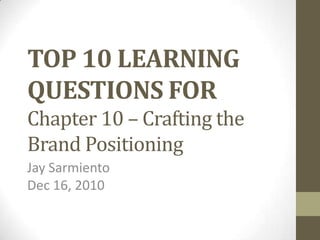Top 10 learning questions for chapter10
- 1. TOP 10 LEARNING QUESTIONS FORChapter 10 ŌĆō Crafting the Brand PositioningJay SarmientoDec 16, 2010
- 2. Chapter 10 ŌĆō Crafting the Brand Positioning1. All marketing strategy is built on STP. What does STP stand for?Service, Technology, ProgressSegregation, Target Market, ProcessSegmentation, targeting, positioning
- 3. Chapter 10 ŌĆō Crafting the Brand PositioningSegmentation, targeting and positioningA company discovers different needs and groups in the marketplace, targets those it can satisfy in a superior way, and then positions its offering so the target market recognizes the company's distinctive offering and image. Answer C
- 4. Chapter 10 ŌĆō Crafting the Brand Positioning2. This is the act of designing the company's offering and image to occupy a distinctive place in the minds of the target market. Corporate IdentityPositioningPublic Relations
- 5. Chapter 10 ŌĆō Crafting the Brand PositioningPositioning distinguishes a company's offering and distinctive image in minds of the target market.Answer B
- 6. Chapter 10 ŌĆō Crafting the Brand Positioning3. Points of DifferenceNike = PerformanceLexus = QualityApple= ?DiversityTechnologyDesign
- 7. Chapter 10 ŌĆō Crafting the Brand PositioningPoints of Difference are attribute or benefits consumers strongly associate with a brand, positively evaluate , and believe they could not find to the same extent with a competitive brand.Answer C
- 8. Chapter 10 ŌĆō Crafting the Brand Positioning4. What are the two basic forms of associated in concern with Points-of-Parity?Category and CompetitiveConsumer and CompetitorCatalog and Categories
- 9. Chapter 10 ŌĆō Crafting the Brand PositioningTwo basic forms of associationCategory points-of-parity they represent necessary- but not sufficient- conditions for brand choice.Competitive points-of-parity are associations designed to negate competitors' points of difference.Answer A
- 10. Chapter 10 ŌĆō Crafting the Brand Positioning5. The product life cycle is typically divided into four (4) stages, which of the following is NOT part of the product life cycle.InceptionGrowthMaturityDecline
- 11. Chapter 10 ŌĆō Crafting the Brand PositioningThe product life cycle consist of the following:Introduction- a period of slow sales growth as the product is introduced in the marketGrowth- rapid growth period
- 12. Chapter 10 ŌĆō Crafting the Brand Positioningc) Maturity- slow down of sales growth as the product gains acceptance.d) Decline- sales shows a downward drift and profits erode.Answer A
- 13. Chapter 10 ŌĆō Crafting the Brand Positioning6. Which of the following has a product life cycle that is hard to predict?StyleFashionFad
- 14. Chapter 10 ŌĆō Crafting the Brand PositioningThe length of a fashion cycle is hard to predict. One point of view is that fashions end because they represent a purchase compromise and consumers start looking for the missing attributes.Answer B
- 15. Chapter 10 ŌĆō Crafting the Brand Positioning7. To achieve a point-of-parity (POP) on a particular attribute or benefit, a sufficient number of consumers must believe that the brand is ŌĆ£________ŌĆØ on that dimension. most excellentNeutralMarginalgood enoughservice-based
- 16. Chapter 10 ŌĆō Crafting the Brand PositioningPoints of Parity are associations that are not necessarily unique to the brand but may in fact be share with other brands.Answer D
- 17. Chapter 10 ŌĆō Crafting the Brand Positioning8. The________ stage of the product is characterized as being one where there is period of rapid market acceptance and substantial profit improvement. introduction growth maturity saturation
- 18. Chapter 10 ŌĆō Crafting the Brand PositioningProduct Life Cycle The growth stage of the product is characterized as being one where there is period of rapid market acceptance and substantial profit improvement. Answer B
- 19. Chapter 10 ŌĆō Crafting the Brand Positioning9. Based on the general bell-shaped curve used to illustrate the product life cycle, which of the following stages is generally seen when the sales curve is at its peak? Introduction Growth Maturity Decline
- 20. Chapter 10 ŌĆō Crafting the Brand PositioningAnswer BChapter 10 ŌĆō Crafting the Brand Positioning10. Which of the following product life cycle do not normally survive because they do not normally satisfy a strong need. StylesFashionsFadsTrend
- 21. Chapter 10 ŌĆō Crafting the Brand PositioningFads fail to survive because they donŌĆÖt normally satisfy a strong need. Their acceptance cycle is short, and they tend to attract only a limited following who are searching for excitement or want to distinguish themselves from others.Answer C






















